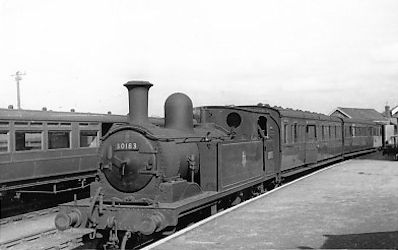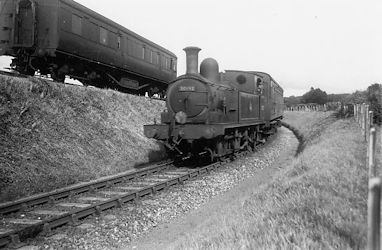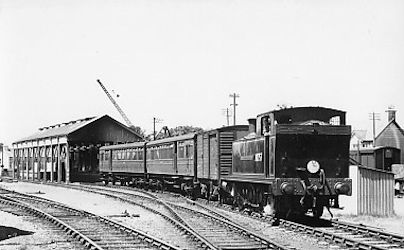|
OLD DEVONPORT
. UK |
||
|
© Brian
Moseley, Plymouth Webpage created: May 03, 2018 Webpage updated: May 10, 2021 |
||
|
RAILWAYS IN OLD DEVONPORT | BRANCH LINES, BERE ALSTON STATION TO CALLINGTON STATION CALLINGTON BRANCH
Number 30183 waiting at Bere Alston Station to
depart with a train for Callington.
Southern Region locomotive number 30192 on the
steep downhill The reader will no doubt ask why the Bere Alston to Callington Branch railway is included in Railways in Old Devonport. The first reason is the junction station, Bere Alston, was on the Southern Railway main line that ran mostly through Old Devonport; and the second reason is that the Tamar Valley, especially around Calstock Station, supplied Devonport Market with much of its inexpensive produce via either the railway or the Devonport Market Boat on the river Tamar. A third, though tenuous reason, is that many workers in the Royal Dockyard chose to move to the Calstock and Gunnislake area during the dark days of the Second World War and the line had through coaches to and from Friary Station in Old Plymouth for those workers, who used to travel to and from Camel's Head Halt and Ford Station.
A very clean Southern Region locomotive number
30757 "Earl of Mount Edgcumbe" The Callington Branch had its origins in a preliminary meeting held in Camp's Hotel, Calstock, Cornwall, on Monday October 18th 1858 to consider the formation of a Joint Stock Stock Limited Liability Company to carry on the manure and coal trades at Kelly Quays, Calstock, 'and for making a railway to be worked by a stationary engine up the incline, to the top of the hill'. Mr Lang, of Cotehele House was asked to be chairman of the meeting, which 'was attended by several influential gentlemen of the neighbourhood'. The appropriate resolutions were passed and £1,000 of the capital was raised immediately. On January 1st 1859 it was announced that the business was to be known as the Tamar Coal, Manure and General Mercantile Company Limited and that the capital of £6,000 was to be in 1,200 shares of £5 each, of which £3 was to be paid up immediately. Mr Thomas Vosper was taken on as manager. That the incline was constructed and opened almost immediately was confirmed in a letter to the Western Morning News on December 6th 1861 (published on Monday December 9th), in which Mr Vosper gave details of the proposal to extend what he called the Tamar and Hingston-Down Railway from the Commercial Wharf, at the top of the incline, past Wheal Edwards and Drakewalls Mines, at Gunnislake, Chilsworthy, Latchley, Hingston-Down Consols Mine, the Landhill and Dimson brickyards, the Kit Hill granite quarries, the Great Wheal Martha and Kit Hill Mines, to Holmbush at Kelly Bray. The line would be below 6 miles in length. He considered that it would cheapen the carriage of goods by 60 to70, per cent. He stated that the cost of horse labour was £100per month alone. In May 1862 the manager, Mr Thomas Vosper, was arrested at his home and brought before the Court. This left the business without a manager, although it seems to have had two managing directors. Firstly they advertised for someone to take the post. It would appear that their advertisement was unsuccessful. Then on May 2nd 1862 an advert appeared in the West Briton newspaper 'To Merchants, Capitalists and Others', offering the business for sale or to let. That was also unsuccessful. Finally, on October 25th 1862 adverts appeared in newspapers both local and as far away as Bristol stating that the 'Extensive River Frontage, Quays, Coal Stores, Limekilns and Railway Incline at Kelly, Calstock, Cornwall, (was) For Sale by Auction.' The auction was to be held at the Ashburton Hotel on Tuesday October 28th 1862 at 3pm, the auctioneer being Mr John March. The write-up is in itself interesting:
The premises were held under lease from Lord Ashburton and another for a Term of sixty years of which forty-six were unexpired. Applications to view the property should be made to the manager, Mr Henry Reynolds, or to the firm's solicitor, Mr Clerverton, at 8 Athenaeum Place, Plymouth. It would seem that the 'Merchants, Capitalists and Others' were still unimpressed. There is no report of the auction and as we shall see the Company were still in occupation when the next development came. On Monday November 23rd 1863 'a large company assembled to witness the cutting of the first sod of a proposed railway to be called the Tamar, Kit Hill and Callington Railway, commencing in the parish of Calstock, in a piece of ground adjoining the river Tamar, and passing through Keely (should have been Kelly), Calstock, Albaston, Gunnislake, Chilsworthy, Latchley, Luckett, Stokeclimsland, Downgate, Holmbush, Kelly Bray and terminating at Callington'. The Company had actually already been formed although it as yet had no Parliamentary authority to construct the railway. The engineer was Mr William D'Arcy, of London, and the contractor was Mr Humphries, of south Wales. In a field belonging to Mrs Bowhay, the workmen formed a crescent, spades on shoulders, while Mr Edward Bowhay, of Albaston, one of the directors of the Tamar Coal, Manure and General Mercantile Company Limited, cut the turf and wheeled it away, to the cheers of those present. The local solicitor of the line, Mr Edward Nicholls, of Callington, then wheeled a barrow of earth to the place where the turf had been cut, and the manager, Mr Symons, the Duchy of Cornwall agent, did likewise. Finally the contractor also wheeled in a barrow of earth, the proceedings being terminated with around of cheers. In January 1864 the Prospectus for the Company was published, inviting applications for the 6,000 £10 shares. The Company Secretary was Mr William Mansell, of 32 Walbrook, London EC, and the London solicitor was Mr Henry Charles Elliott, of 69 Lincoln Inn's Fields. The Board of Directors comprised: Mr James Bancks, of Broxbourne; Mr John Burbidge, of 48 Gloucester Place, Portman Square, London; Mr Henry Cook, of 69Lincoln Inn's Fields, London, and Eastbourne, a director of Bonell's Telegraph Company; Mr John Downes, of 135 Upper Thames Street, London EC; Mr Saint George C D'Arcy Irvine, of Manchester Buildings; Mr Charles Kitto, of 3 East India Avenue, Leadenhall Street, London EC and of Wilton House, Highbury; Mr Henry Ledgard, of 32 Wood Street, London EC. Sitting with them were the directors of the Tamar Coal, Manure and General Mercantile Company Limited, Mr Francis Raddall, of Penscombe, Lezant; Mr Francis Blake, of Llandue, Launceston; Mr Edward Bowhay, of Albaston, Calstock; Mr John Henwood, of Millbrook, Devonport (!); and Mr Robert Pote Stephens, of Millbrook, Devonport. The company's bankers were |Messrs Dingley and Company,Launceston and Callington, and the Consolidated Bank, in London and Manchester. So the first turf had been cut, work was progressing, the Act of Parliament was granted on July 9th 1864, and the railway might have been completed if someone had not come up with an even better plan: to link Callington to the broad-gauge Cornwall Railway at Saltash. A public meeting was called 'to consider the present and future prospects of the Tamar, Kit Hill and Callington Railway' and held on Wednesday August 24th 1864 at Golding's Hotel, Callington, Mr Martin Body, Portreeve, in the chair. It was well attended and included Mr Mr James Bancks, chairman of the directors; Mr A L Schimmel-Pennick, Mr George Schweck, Mr Geyrge D'Arcy Irvine, all directors; Mr W W Mansel, secretary; Mr John Gurney, the Company's London solicitor; and Mr Edward Nicholls, the Company's solicitor at Callington. As the Royal Cornwall Gazette put it in their later report: 'In the course of the proceedings, Mr W Dingle proposed: "That this meeting hopes that the promoters of the Tamar, Kit Hill and Callington Railway will initiate a project to connect Callington with Saltash by a railway; and also to form a junction between this town and the Launceston, Bodmin and Wadebridge Railway, and considers that landowners and others throughout the respective districts will be promoting their own interest by giving the scheme their support". In doing sohe complained that it had only been placed inhis hands a few minutes previously. The resolution was one with which he perfectly agreed.' In other words, Saltash was seen as a much better place to be linked to than Calstock.
1862 the Tamar, Kit Hill and Callington Railway Company were authorised by Act of Parliament, to construct a railway from the mines around Callington, in East Cornwall, to the quay at Calstock, on the river Tamar, where their products could be transferred to boats to be shipped all over the world. Although work started on the line in 1863, it came to a grinding halt three years later because of a financial recession. In 1869 the project was revived by a new enterprise, the Callington and Calstock Railway Company. They changed their name to the East Cornwall Mineral Railway Company, who acquired the legal powers to complete the construction of the line to a gauge of 3 feet 6 inches and declare it officially open on May 7th 1872. There were no passenger stations only mineral depots and private sidings to mines and quarries. Following the opening by the Plymouth, Devonport and South Western Junction Railway Company of their new main line between Lydford Station and Devonport Station in 1890, they purchased the East Cornwall Mineral Railway Company the following year with a view to extending it to link up with their main line. They obtained the Bere Alston and Calstock Light Railway Act and in 1908 opened the extension from Calstock Station over the Calstock Viaduct and up a steep incline to Bere Alston Station. In addition they changed track to standard-gauge (4 feet 8½ inches) and upgraded it to enable passenger trains to be run. A number of Stations were opened, mostly at or near the sites of the mineral depots, and even Halts appeared. Although the main line was taken over by the London and South Western Railway Company, the branch line was retained by the Plymouth, Devonport and South Western Junction Railway Company and worked by their own locomotives and rolling stock until it was absorbed into the Southern Railway Company at the Grouping of 1923. On January 1st 1948 it was, of course, nationalized and became part of British Railways Southern Region. In 1960 the maximum loads permissible on the Branch for the two types of locomotives most commonly used (the O.2 and the Ivatt 2MT tanks) were:
The Regulations in October 1960 stated: The gradients throughout this branch are severe and hand brakes in the minimum proportion of one to every two loaded or three empty wagons must be applied on all freight and mixed trains before descending any decline. In adverse weather additional brakes must be applied as the conditions necessitate. Guards must ascertain from drivers the number of brakes to be applied to enable trains to be effectively controlled. Fully fitted wagons must be marshalled at the front of the train as far as possible and the hose pipes connected, the number of wagons so connected to be included in the brake power referred to previously'. An attempt to modernise the line by the introduction of diesel multiple units in 1964 was nearly an unmitigated disaster. The Callington Branch was destined for complete closure but because of the difficulty of road access to the area around Calstock only the section from Gunnislake Station to Callington Station was closed to traffic on and as from November 5th 1966. The remaining section was amalgamated with the remnant of the old Southern main line through Old Devonport to create the modern Gunnislake Branch.
|
||
|
The author's Father lived at Calstock during
1941 and told of having to walk across
Calstock Viaduct in the dark if the last Branch train had left Bere Alston before the train from Ford Station had arrived. The Viaduct was guarded by the Home Guard and so he always challenged. |
||


